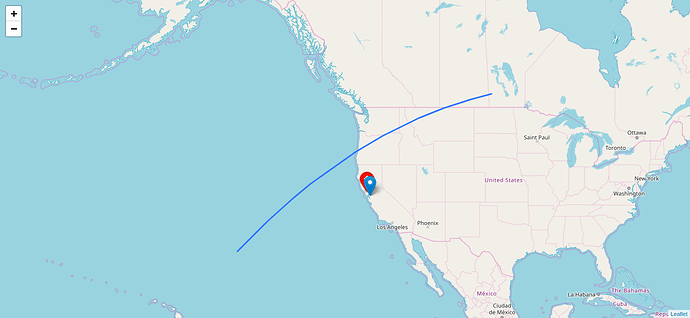Walford Anglican School for Girls, Adelaide, South Australia, Australia, telebridge via W6SRJ
The ISS callsign is presently scheduled to be NA1SS
The scheduled astronaut is Ricky Arnold KE5DAU
Contact is a go for: Wed 2018-09-12 08:21:02 UTC 31 deg
One station was able to receive part of the contact:
Map of the ground track, the above mentioned SatNOGS ground stations and the contact site:
Congratulations and 73 to all!
Video stream: Streamer – British Amateur Television Club
More details about the contact from AMSAT-BB:
Click here for the details
An International Space Station school contact has been planned with participants at Walford Anglican School for Girls, Adelaide, South Australia, Australia on 12 Sept. The event is scheduled to begin at approximately 08:21 UTC. It is recommended that you start listening approximately 10 minutes before this time.The duration of the contact is approximately 9 minutes and 30 seconds. The contact will be a telebridge between NA1SS and W6SRJ. The contact should be audible over portions of Australia and adjacent areas. Interested parties are invited to listen in on the 145.80 MHz downlink. The contact is expected to be conducted in English.
Watch for live simulcast at: Streamer – British Amateur Television Club
Walford is a dynamic girls’ school offering a friendly, family-orientated environment where each student is encouraged to be the best she can be. Progressive teaching and guidance are provided in state-of-the-art facilities to provide our students with the very best preparation to follow their future ambitions. Our school is a vibrant community where learning is prioritised and lifelong friendships formed. Our campus is designed to facilitate positive interactions across year levels and to provide the sense of belonging and connectedness that each girl should feel with her school.
Participants will ask as many of the following questions as time allows:
-
What is the most interesting experiment you have performed or seen performed in space and why?
-
With all the space junk flying around the Earth, some of it being really small, how do you know when it’s safe to go outside for spacewalks so that you don’t get hit by any of it?
-
Can you see the impact of climate change from space?
-
Has an astronaut every become very ill while you have been on the Space Station and how was it dealt with?
-
What do you expect to see changing in space flight in the coming years?
-
What is the hardest thing about living in space?
-
Has becoming an astronaut always been your dream?
-
What advice would you give to students thinking about a career in space exploration?
-
What training do you have to go through to go into space?
-
How are the experiments you perform on the ISS decided?
-
Do you get less sleep than a person on Earth due to the sun setting and rising every 92 minutes?
-
What is the most used room, area or object on the space station and why?
-
How is NASA using artificial intelligence to find life in outer space?
-
What is the most interesting thing that you have learnt in space?
-
What are the coolest things that you have seen during your time on the space station, both looking back at the earth and looking into outer space?
-
Does being an astronaut change your perspective on humanity as you get to experience seeing the world as a whole?
-
Do you have to do every day chores such as washing on the Space Station? What makes some of these chores difficult?
-
What is the best way to describe the feeling of being surrounded by zero gravity?
-
How do you keep up with the news back on Earth?
-
What is the hardest everyday task to do when you are in space?
-
How long does it take your body to adjust to conditions on Earth after having been in space for an extended period of time?
-
What do you miss the most about Earth when you are in space for long periods of time?
-
How has recent research on the ISS affected life on Earth?
-
What time zone do you follow in space?
-
What would you say is the most important part of being an astronaut?
-
How likely do you think it will be that humans will inhabit Mars or the moon?
[…]
About ARISS:
Amateur Radio on the International Space Station (ARISS) is a cooperative venture of international amateur radio societies and the space agencies that support the International Space Station (ISS). In the United States, sponsors are the Radio Amateur Satellite Corporation (AMSAT), the American Radio Relay League (ARRL), the Center for the Advancement of Science in Space (CASIS) and National Aeronautics and Space Administration (NASA). The primary goal of ARISS is to promote exploration of science, technology, engineering, and mathematics (STEM) topics by organizing scheduled contacts via amateur radio between crew members aboard the ISS and students in classrooms or informal education venues. With the help of experienced amateur radio volunteers, ISS crews speak directly with large audiences in a variety of public forums. Before and during these radio contacts, students, teachers, parents, and communities learn about space, space technologies, and amateur radio. For more information, see www.ariss.org, www.amsat.org, and www.arrl.org.
Thank you & 73,
David - AA4KN
